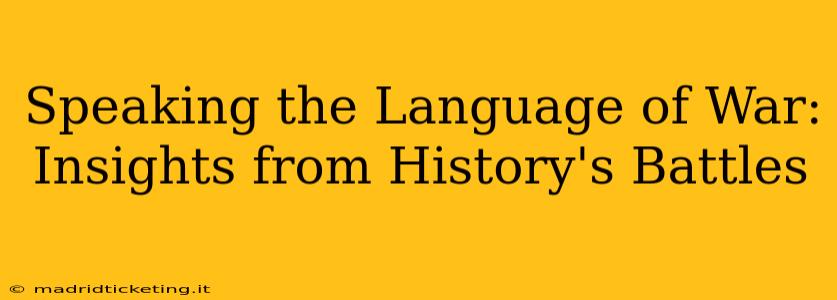War, throughout history, has been far more than just brute force and bloodshed. It's a complex interplay of strategy, communication, and psychology, a language spoken through actions, symbols, and the very terrain itself. Understanding this "language of war" offers invaluable insights into past conflicts and, perhaps surprisingly, into the dynamics of peace and conflict today. This exploration delves into the multifaceted communication strategies employed in warfare, drawing upon historical examples to illuminate the subtle nuances and profound impact of this often-overlooked aspect of conflict.
The Role of Communication in Military Strategy
Effective communication is the lifeblood of any successful military campaign. From ancient times to modern warfare, the ability to relay orders swiftly and accurately, coordinate troop movements, and maintain morale has been paramount. Consider the meticulous planning and precise signal communication employed by Alexander the Great, whose army, despite logistical challenges, achieved remarkable victories through efficient communication systems. His use of couriers and signal fires allowed him to maintain cohesion and react swiftly to changing battlefield situations. This highlights that strategic communication isn't merely about conveying information; it's about enabling decisive action.
How Propaganda Shapes Public Opinion During Wartime
Propaganda, often viewed negatively, is a critical element in the "language of war." It aims to sway public opinion both domestically and internationally, bolstering support for the war effort and demonizing the enemy. World War I saw an unprecedented use of propaganda, shaping the narratives of nations and influencing the course of the conflict. Posters, newsreels, and speeches cultivated patriotic fervor and fostered hatred towards the opposing side. Understanding the techniques of propaganda allows us to critically analyze information and identify bias, even in contemporary contexts.
How did propaganda impact the civilian population during World War II?
Propaganda in World War II was even more sophisticated, leveraging advancements in media technology to reach wider audiences. Governments utilized radio broadcasts, films, and print media to create a unified national identity and justify the war effort. This resulted in increased support for the war on the home front, but also in the suppression of dissent and the spread of misinformation. Examining specific campaigns from both Allied and Axis powers reveals the effectiveness – and potential dangers – of manipulative communication in wartime.
The Importance of Nonverbal Communication on the Battlefield
Beyond verbal communication, the battlefield is rich with nonverbal cues. The positioning of troops, the use of flags and signals, even the terrain itself, all contribute to the "language of war." Consider the strategic use of terrain in the Battle of Thermopylae, where a small Spartan force utilized the narrow pass to slow down and defeat a vastly larger Persian army. The very landscape became a powerful tool of communication, dictating the flow of battle and amplifying the Spartans’ defensive capabilities. Understanding these nonverbal cues is crucial to deciphering military strategies and predicting enemy movements.
Decoding Military Symbols and Signals
Throughout history, armies have developed intricate systems of symbols and signals for communication. From smoke signals to semaphore flags, these systems allowed for rapid and covert communication, crucial in situations where verbal communication was impossible or too risky. Analyzing these historical systems reveals the ingenuity and creativity employed in overcoming communication challenges in war. The complexity of these systems also points to the sophistication of military planning and the importance of secure communication in military success.
What role did technology play in changing military communication?
The advent of technology has revolutionized military communication, offering unparalleled speed and range. From the telegraph to the internet, advancements in communication have dramatically changed the dynamics of warfare, allowing for real-time coordination and rapid deployment of forces. However, technology also presents new vulnerabilities, as seen in the potential for cyber warfare and the interception of sensitive information.
The Language of Peace Negotiations: Communication After the Guns Fall Silent
The "language of war" doesn't end with the cessation of hostilities. Negotiating peace requires careful diplomacy and clear communication, often involving complex negotiations and compromises. The Treaty of Versailles, while a landmark peace agreement, also exemplifies the challenges and pitfalls of post-war communication, highlighting the importance of clear articulation, mutual understanding, and a commitment to addressing the underlying causes of conflict. Understanding these dynamics is crucial for building lasting peace and preventing future wars.
In conclusion, exploring the "language of war" through the lens of history offers a compelling insight into the intricate interplay of strategy, communication, and psychology that shape the course of conflict. From ancient battlefields to modern conflicts, understanding the methods of communication employed in wartime – both verbal and nonverbal – is essential for comprehending the complexities of human conflict and striving for a more peaceful future.

